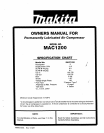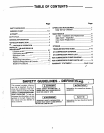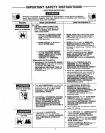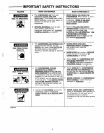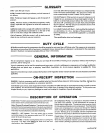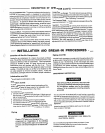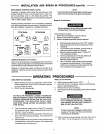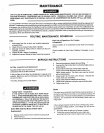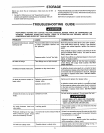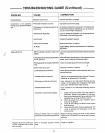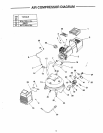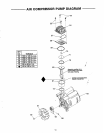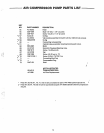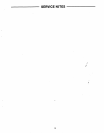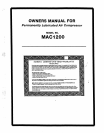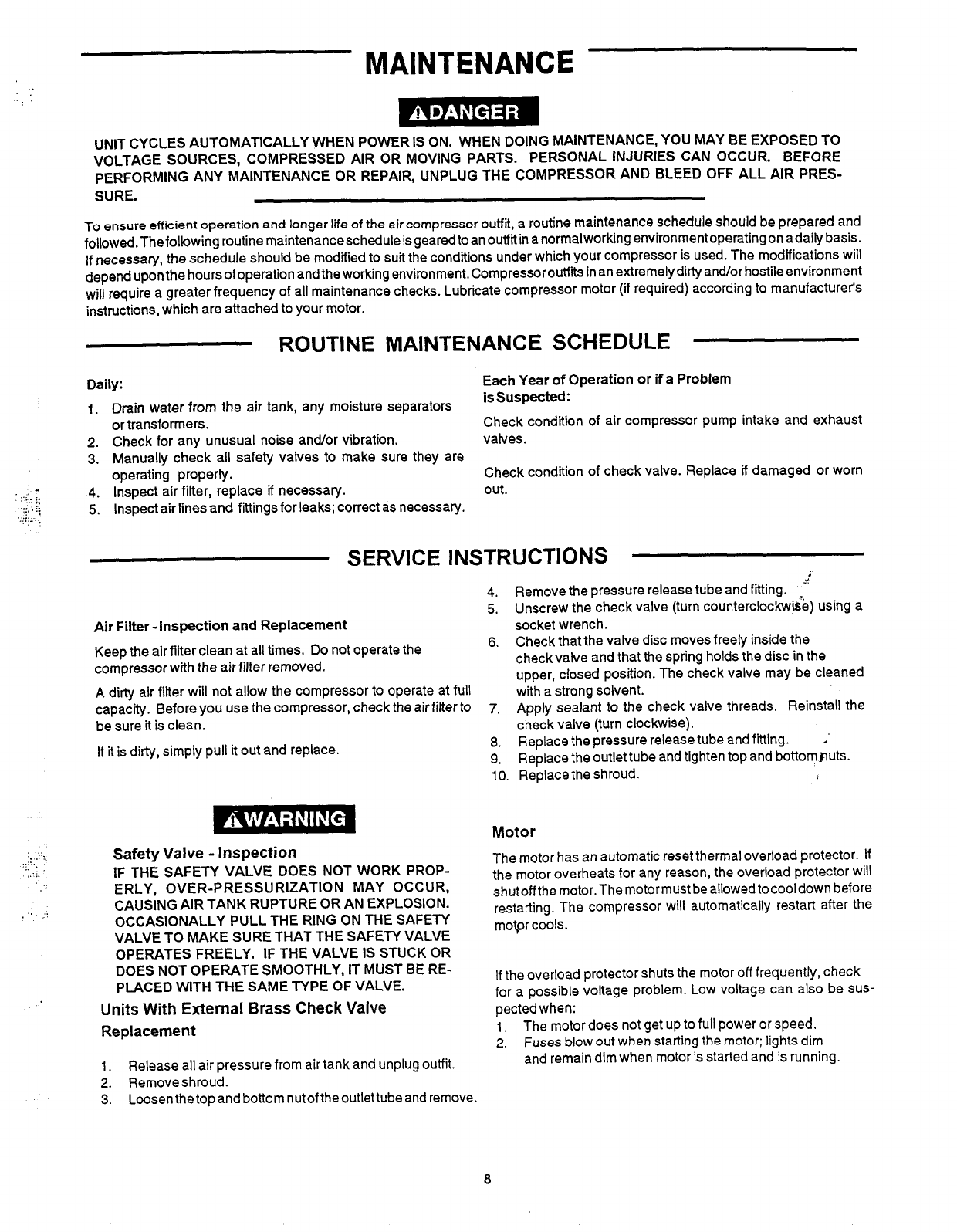
MAINTENANCE
UNIT CYCLES AUTOMATICALLY WHEN POWER
IS
ON. WHEN DOING MAINTENANCE, YOU MAY BE EXPOSED TO
VOLTAGE SOURCES, COMPRESSED AIR OR MOVING PARTS.
PERSONAL INJURIES CAN OCCUR. BEFORE
PERFORMING ANY MAINTENANCE OR REPAIR, UNPLUG THE COMPRESSOR AND BLEED
OFF
ALL AIR PRES-
SURE.
To
ensure efficient operation
and
longer
lie
of
the
air
compressor outfii, a routine maintenance schedule should be prepared and
followed.Thefolbwing routine
maintenancescheduleisgearedto
an outfiit in a normalworking environmentoperating on adaily basis.
If
necessary, the schedule should be modified to suit the conditions under which your compressor is used. The modifications will
depend uponthe hours of operation and the working environment. Compressoroutfiks in an extremely dirty and/or hostile environment
will require a greater frequency of all maintenance checks. Lubricate compressor motor (if required) according
to
manufacturer's
instructions, which are attached to your motor.
ROUTINE MAINTENANCE SCHEDULE
..
...
.
.
...
..
.-,
..
.
..
....
..
,:.
,
.:
.
...
.....
.
.. ..
Daily:
1.
Drain water from the air tank, any moisture separators
or transformers.
2.
Check for any unusual noise and/or vibration. valves.
3. Manually check all safety valves
to
make sure they are
operating properly.
5.
Inspect air linesand fittings for leaks; correct as necessary.
Each Year
of
Operation or ifa Problem
is
Suspected:
Check condition
of
air compressor pump intake and exhaust
Check condition of check valve. Replace if damaged or worn
4.
Inspect air filter, replace
if
necessary. out.
SERVICE INSTRUCTIONS
Air Filter -Inspection and Replacement
4.
Remove the pressure release tube and fitting.
-'
5.
Unscrew the check valve (turn counterclockw$e) using a
socket wrench.
6.
Check thatthe valve disc movesfreely inside the
checkvalve and that the spring holds the disc in the
upper, closed position. The check valve may be cleaned
with a strong solvent.
Apply sealant to the check valve threads. Reinstall the
check valve (turn clockwise).
Keep the air filter clean at all times.
Do
not operate the
compressor with the air filter removed.
A dirty air filter will not allow the compressor
to
operate at full
capacity. Before you use the compressor, check the air filter to
be sure
it
is
clean.
7.
If
it
is dirty, simply pull
it
out and replace.
8.
9.
10.
Replacetheshroud.
Replace the pressure release tube and fitting.
Replace the outlettube and tighten top and bottomputs.
Motor
Safety Valve
-
Inspection
IF THE SAFETY VALVE DOES NOT WORK PROP-
ERLY, OVER-PRESSURIZATION MAY OCCUR,
CAUSING AIR TANK RUPTURE OR AN EXPLOSION.
VALVE TO MAKE SURE THAT THE SAFETY VALVE
OPERATES FREELY.
IF THE VALVE
IS
STUCK OR
DOES NOT OPERATE SMOOTHLY, IT MUST BE
RE-
PLACED WITH THE SAME TYPE
OF
VALVE.
The motor has an automatic reset thermal overload protector.
If
the motor overheats for any reason, the overload protector will
shutoffthe motor.Themotormustbe allowedtocooldown before
restarting. The compressor will automatically restart after the
OCCASIONALLY PULL THE RING
ON
THE SAFETY
motprcoo~s.
If
the overload protector shuts the motor
off
frequently, check
for a possible voltage problem. Low voltage can
also
be
SUS-
pected when:
1.
2.
Units
With
External
Brass
Check
Valve
Replacement
1.
Release all air pressure from air tank and unplug outfit.
2.
Removeshroud.
3.
Loosenthetopandbottomnutoftheoutlettubeand remove.
The motor does not get up to full power or speed.
Fuses blow out when starting the
motor;
lights dim
and remain dim when motor is started and is running.
8



